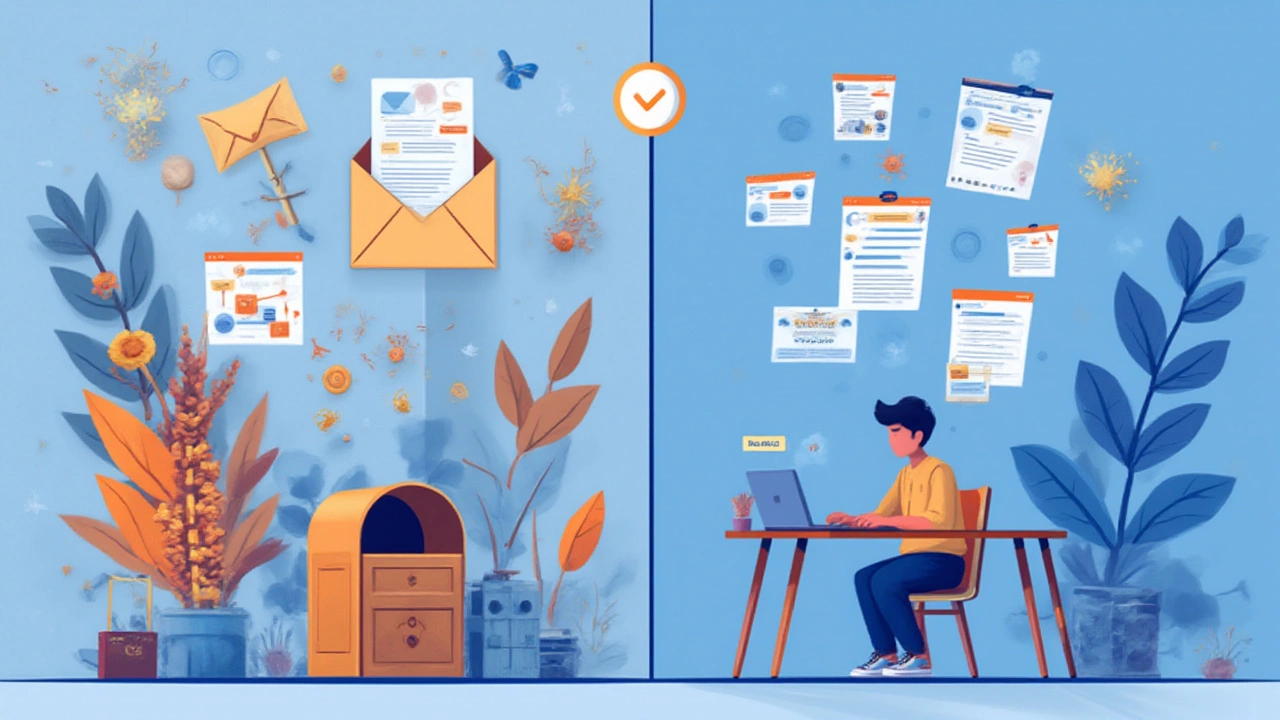Think you know what distance learning is? Chances are, you’ve been using the term interchangeably with online learning for years. But here’s the thing: Those late-night YouTube study sessions or virtual Zoom lectures might not mean you’re a distance learner—at least, not in the way universities used to define it. The confusion isn't surprising. Institutions and even education policymakers sometimes blur the lines. But there are real, concrete differences. And knowing them can save you time, money, and a world of frustration if you’re trying to pick the right learning format. Let’s peel back the curtain and get clear on what’s what.
Breaking Down the Basics: What Exactly Are Distance and Online Learning?
First up, let’s talk definitions—the kind you could take to the bank. Distance learning isn’t new. The roots go right back to the 19th century, when students in the UK and US would mail in their assignments and wait weeks for feedback. A classic example: The University of London rolled out external studies in the 1850s, sending course materials by post to distant students. Fast-forward to the 1980s and ‘90s—distance learning got a tech upgrade, with lectures on videotape, radio, and even TV broadcasts. Surprisingly, the first online degree programs didn’t pop up until the late 1990s. Online learning, on the other hand, grew out of the digital revolution and is powered entirely by the internet. Here, you’ve got video calls, discussion boards, instant grading, cloud tools, and real-time interactions.
It helps to picture distance learning as the parent, with online learning as its internet-age child. Distance learning means any education where the student and instructor aren't physically in the same place—whether that’s by post, radio, USB stick, or digital platform. Online learning always happens with internet connectivity, using web-based tools. That’s why all online learning counts as distance learning, but not every distance learning program is online.
Think of it this way. If you take an MBA program where you receive textbooks by courier and send scanned assignments back (because the village WiFi is patchy and no smartphone in sight), you’re a distance learner. When you get daily quizzes and join nighttime webinars from your hostel room, that’s *online learning*. As of 2024, nearly 92% of US colleges offer at least some form of online learning, but only 46% still support traditional distance learning without real-time digital elements. India’s IGNOU, for instance, is one of the world’s largest open universities where students use both modes depending on their region and connectivity.
Want a simpler breakdown? Check the table below:
| Aspect | Distance Learning | Online Learning |
|---|---|---|
| Mode of delivery | Mail, TV, radio, digital, or online | Always online with internet |
| Materials | Textbooks, printed notes, DVDs, LMS platforms | All digital—PDFs, videos, quizzes, forums |
| Interaction | Low, often via mail or phone | Real-time chats, video calls, instant feedback |
| Flexibility | High (self-paced, sometimes no deadlines) | High, but may require scheduled online sessions |
| Assessment | Mainly assignments, some offline exams | Online quizzes, interactive tests, projects |
The lines between the two have blurred with modern tech, but the core structure still sets them apart. Remember, while online learning is a dynamic offshoot, distance learning can exist perfectly fine without online tools. So if you spot a course offering "distance mode" in rural locations with no digital tech, don’t expect any trendy apps or real-time polls!

How the Student Experience Differs: Interaction, Flexibility, and Pace
Let’s go beyond the technical stuff and talk about what these differences actually mean for your day-to-day life as a learner. Imagine two students: Maya, who’s taking an online coding bootcamp, and Arun, attending a distance law program via correspondence from a university in another state. Their experiences aren’t even close.
Maya logs onto her laptop every morning and greets her instructors and classmates via Slack. She watches recorded coding tutorials, submits weekly projects, receives marks instantly, and joins live Q&A sessions. If she gets stuck, she posts a question and gets answers in minutes. Her learning space is social, digital, and—if she misses a day—she can often catch up with recorded sessions or drop a message on a forum.
Arun’s world is different. He gets a set of printed materials every semester. Assignments arrive by mail or sometimes email, but the bulk of guidance comes via notes or old recorded lectures. If he has a question, he can try phoning the faculty or mailing in a letter, but he might wait days (sometimes weeks!) for a response. Peer interaction is nearly zero unless he joins a study group in his own city. For exams, he meets at an approved center—no web proctoring, no live chat. The whole thing is self-paced, sometimes dragging out over years.
This contrast is huge when it comes to engagement. Online learning offers instant connections—video mentoring, group projects done over Google Docs, shared screen coding sessions. Some platforms, like Coursera or Udemy, even use “leaderboards” to nudge competition. Discussion threads provide a constant stream of Q&A and camaraderie. If you’re a social learner who likes feedback, online learning fits like a glove.
But distance learning has unique strengths. Ultra-flexible timing appeals to those juggling work, family, or weak internet. Self-motivation is key; you set your own pace, sometimes finishing courses in a fraction of the usual time (or stretching it out as long as you need). It’s also a great leveller for folks in remote areas or those uncomfortable with lots of digital tools.
Pro tip: Before enrolling, always check the fine print. Some universities call their correspondence courses “online” even if most delivery is on paper. If you want constant support and community, make sure the course promises interactive elements—check for active discussion boards, video calls, or live help. If you value independence, a distance-only course may work best. There’s no right or wrong, only what fits your style.
Let’s not forget the numbers. According to a 2023 survey, dropout rates for fully online degree programs in the US hovered near 41%, but for pure correspondence-based distance learning it peaked at 52%. The gap highlights just how vital real-time support can be in keeping motivation high. Still, completion rates climb when programs blend both modes—offering offline flexibility but with digital support where possible.

Picking the Right Mode for You: Tips, Myths, and Cost Differences
Okay, so how do you actually choose between distance and online learning? Start by getting honest about your goals, connectivity, and lifestyle. Here’s a checklist to help you match the right model to your needs:
- Do you crave real-time feedback and community? If yes, steer toward online learning platforms. Look for courses labeled “live” or “interactive” and try demo sessions before committing.
- Are you in a remote area with spotty internet or unusual work hours? Traditional distance learning, with offline materials and flexible pacing, may work better.
- Worried about tech overload? Courses that blend printed resources with online support might ease the transition.
- On a budget? Check costs closely. While both distance and online learning can be more affordable than campus study, online learning fees may sneak up due to software subscriptions or exam proctoring. Government subsidies often support distance education programs in developing countries—India’s SWAYAM, for instance, offers thousands of courses at almost no cost to students, with both pure distance and online options.
- Are recognized degrees a priority? Always check accreditation and employer recognition. Some prestigious universities offer distance degrees that hold the same weight as their regular courses, while others are clear about “online only” diplomas.
Let’s destroy a common myth: Online learning is not necessarily easier. In fact, surveys by the UK Open University reveal that most students report online learning requires strong time management and self-discipline—sometimes more than in traditional correspondence (distance) models, because deadlines are tighter, and distractions lurk at every digital corner. But online learning’s built-in accountability—those pop-up reminders and regular quizzes—can be a savior for the easily distracted.
Another overlooked point: accessibility. For students with physical disabilities, online platforms can be a blessing. Screen readers, closed captions, font customization, and voice command features mean equal access to materials—a benefit pure correspondence learning struggles to match. Of course, this only helps when internet access is reliable.
Don’t forget the job market. Many employers, especially in tech, now consider online credentials equivalent to on-campus ones. According to the World Economic Forum’s 2024 Skills Outlook, digital certifications like Google’s Project Management or AWS Cloud badges (earned entirely online) are becoming recruitment gold. But industries like law or medicine may prefer degrees from established distance education universities or demand periodic in-person workshops—even if the bulk of learning happens remotely.
Got your eye on the future? Hybrid models are taking over. By 2025, more than 67% of professional development programs worldwide are blending distance education with online learning—sending out printed handbooks but holding monthly webinars, combining offline projects with virtual presentations. This “best of both worlds” model aims to smash barriers—digital and physical—so you can learn where, when, and how you want.
The bottom line is this: there’s no one-size-fits-all. Distance learning and online learning aren’t rivals—they’re different tools for different jobs. The trick is knowing how each one fits your life right now. Before you sign up, ask questions, trial a module if you can, read reviews, and always demand as much clarity as possible. Because once you know what you’re signing up for, you can make these modes work full power for you.
